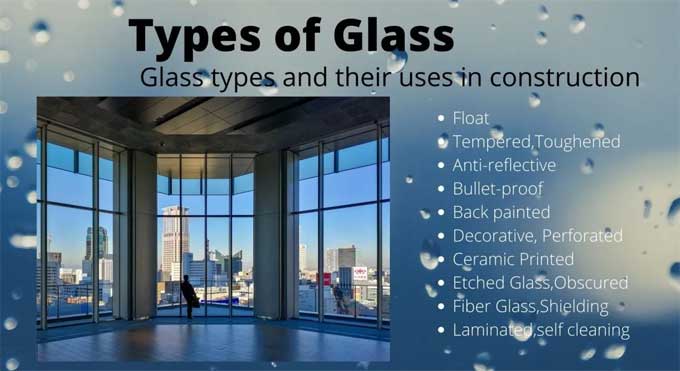
What are the top 5 types of Glass for Construction and how do they work?

There are many styles and varieties of glass available as with most building materials. Security glass, aesthetic glass, privacy glass, and insulation glass all differ a bit in purpose and appearance. Changing their manufacturing processes can increase their strength, change their colors, and even make them safer to break. There are at least a few practical uses for each of these types of glass.
Glass Properties
Transparency: It is also possible to determine the best use of a sheet of glass based on its transparency. A clear glass window, door, or glass case can be a good choice.
For privacy situations like shower glass and neighbor facing windows, glass obscured by frost, structural irregularities, window film, or tinted hues can be useful. The ultraviolet rays of the sun can also be blocked by tinted glass.
Strength: A glass' strength is one of its most important characteristics, regardless of its impact resistance or weight bearing capacity. Storefront glass, display cases, or tall windows should be made of thick, impact resistant glass. Aquariums, suspended walkways, and other applications can be made from glass with high weight bearing capacities. Lamination can be done with thinner, weaker glass if it is thinner and stronger than the rest of the glass.
U Value: In simple terms, U Value indicates how well heated or cooled air passes through a sheet of glass. Glass with a low U Value is limited in its application, while glass with a high U Value is most beneficial for use in windows and doors.
Types of Glass in Construction
Annealed Glass: The annealing process transforms float glass into annealed glass. By blasting cold air onto one side of the glass, float glass is slowly cooled. As a result, glass is extremely clear, free of imperfections and internal stresses. Cutting and shaping are easy with it.
In addition to window glass, annealed glass can also be used to create other types of glass, such as laminated or tempered glass.
Heat Strengthen Glass: As with tempered glass, heat strengthened glass is strengthened by heating and cooling. The cool down rate of heat strengthen glass is faster than regular glass, which releases tension within the material.
With this process, the glass becomes twice as strong as float or annealed glass while maintaining a similar break pattern, meaning it breaks into larger shards that generally remain in the frame. For high temperatures, environments, where float or annealed glass may be affected by thermal stresses, make it popular.
Insulated Glass: Insulated Glass inhibits the transfer of heat from a window or door to the interior. The glazing is not insulated & it is made up of two or more sheets of glass, a space between them, an inert gas between the sheets, and a frame.
Heat is trapped on one side of the glass by the space between the two panes of glass, preventing it from traveling along the thermal bridge. On hot days, the heat is kept outside, and on cold days, it is kept inside.
The use of insulated glass is common in windows, doors, or anywhere heat loss is a likely and undesirable result. An annealed or laminated glass pane is usually used in these windows.
Laminated Glass: The term laminated glass refers to a type of glass made of two or more sheets of annealed glass sandwiched between thin layers of translucent material.
It's typically made from polyvinyl butyric and keeps the glass in place if one or more of the panes break. These panels are also much stronger and less likely to break due to the double layers and the film. As a result, laminated glass is also called safety glass.
Laminated glass is commonly used in doors, windows near walkways, and windows that require additional security. As a general rule, laminated glass is used for glass panes larger than 9 square feet or windows frequently exposed to tornadoes or hurricanes.
To learn more, watch the following video tutorial.
Video Source: Olous App
Mirrored Glass: While the float glass is completely clear, the metal film reflecting the image to the person is typically silver or aluminum.
The coated glass that reflects images and light is called mirrored glass. The manufacturer coats one side of float glass with a metal material. The metal of choice is boiled and placed on top of the sheet of float glass to adhere to it. A permanent bond is formed between the metal atoms and the sheet of glass as they cool.
Mirrored glass is primarily used for aesthetic purposes, such as in bathrooms for shaving and makeup. This type of glass is also used in wall mounted mirrors and automobiles.


